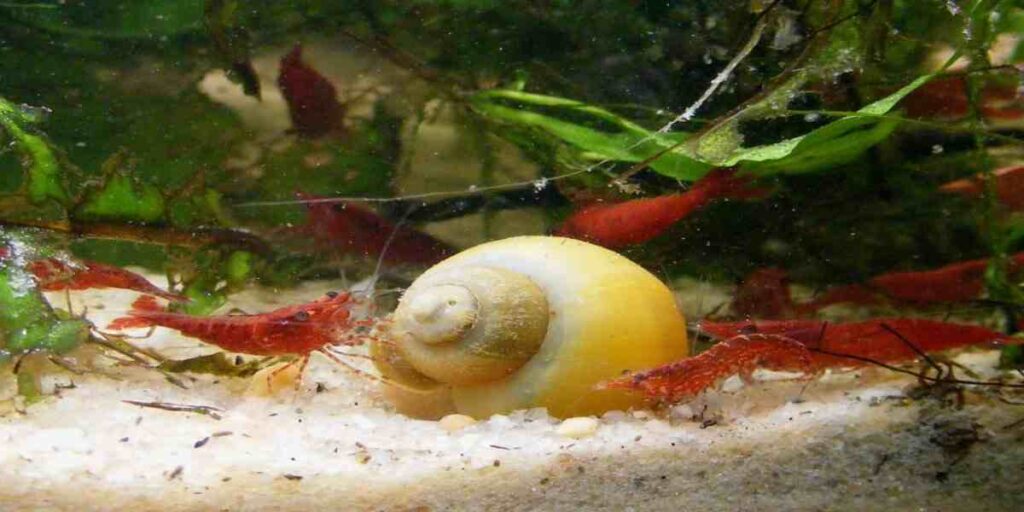
“Discover why your mystery snail not moving hanging out of shell. Learn common causes and effective solutions. Ensure your aquatic friend’s well-being today!
- What are Mystery Snails?
- What are the Common Causes of Mystery Snails Not Moving and Hanging Out of Their Shells?
- What are the Signs that a Mystery Snail is Dying?
- Solutions
- Solution 1: Check and Adjust Your Water Parameters
- Solution 2: Feed Your Snail a Variety of Nutritious Foods
- Solution 3: Inspect Your Snail for Injuries or Signs of Disease and Treat Accordingly
- Solution 4: There is No Cure for Old Age, but You Can Make Your Snail’s Remaining Time as Comfortable as Possible
- Solution 5: If You are Unsure of the Cause of Your Snail’s Lethargy, Consult with a Veterinarian or Experienced Aquarist
- Conclusion
If you’re an aquarium enthusiast or a proud owner of a mystery snail, you may have encountered the concerning sight of your aquatic friend not moving and hanging out of its shell. This behavior can be unsettling but fear not – in this article, we will explore the common causes of mystery snails exhibiting such behavior, how to identify signs of distress, and what you can do to help your snail regain its vitality.
What are Mystery Snails?
Mystery snails (Pomacea spp.) are popular freshwater snails known for their vibrant colors and unique behaviors. They are a great addition to aquariums because of their algae-eating habits and peaceful disposition. However, like any aquatic creature, mystery snails can face health issues that may manifest as lethargy or inactivity.
What are the Common Causes of Mystery Snails Not Moving and Hanging Out of Their Shells?

Before you can effectively address the issue, it’s crucial to understand the underlying causes. Here are the most common reasons why your mystery snail might be lethargic:
Cause 1: Poor Water Quality
One of the leading causes of mystery snail distress is subpar water quality. Snails are highly sensitive to changes in their environment, especially water parameters like pH, ammonia, nitrites, and nitrates. If these levels are not within acceptable ranges, your snail may become stressed and lethargic.
Cause 2: Lack of Food
Mystery snails are herbivores and rely on a consistent supply of food, primarily algae and vegetables. A lack of appropriate nutrition can weaken them and lead to inactivity.
Cause 3: Injury or Disease
Injuries or diseases can significantly impact a mystery snail’s behavior. Physical injuries from rough handling or sharp tank decorations can cause stress, while infections can lead to lethargy and hanging out of the shell.
Cause 4: Old Age
Like all living creatures, mystery snails have a natural lifespan. If your snail is approaching the end of its life cycle, it may become less active and spend more time outside its shell.
Cause 5: Other Factors
Several other factors can contribute to mystery snail lethargy. These include aggressive tankmates that harass or stress the snail, the presence of harmful chemicals in the water, or sudden changes in temperature or lighting conditions.
What are the Signs that a Mystery Snail is Dying?
It’s essential to differentiate between a snail that is temporarily inactive and one that is genuinely in distress. Signs that your mystery snail might be dying include:
- Prolonged inactivity: If your snail hasn’t moved for several days or weeks, it could be a cause for concern.
- Foul odor: A foul smell emanating from your snail’s tank can indicate decomposition and a severe health issue.
- Visible damage or discoloration: Physical injuries or signs of disease may be apparent on the snail’s shell or body.
- Irregular shell growth: A misshapen or cracked shell can be indicative of underlying health problems.
Now that you understand the potential causes and signs of a distressed mystery snail, let’s delve into practical solutions to address these issues.
Solutions
Solution 1: Check and Adjust Your Water Parameters
Maintaining pristine water quality is paramount for the well-being of your mystery snail. Regularly test the water for pH, ammonia, nitrites, and nitrates to ensure they are within acceptable ranges. If any parameters are off, take corrective actions such as water changes or using water conditioners to detoxify harmful substances.
Solution 2: Feed Your Snail a Variety of Nutritious Foods
A well-balanced diet is crucial for the health of your mystery snail. Ensure your snail has access to algae, blanched vegetables (such as zucchini or spinach), and commercial snail pellets. Variety in their diet will provide essential nutrients and help prevent malnutrition.
Solution 3: Inspect Your Snail for Injuries or Signs of Disease and Treat Accordingly
Carefully examine your snail for any visible injuries or unusual markings. If you detect signs of physical damage, remove sharp tank decorations, and create a gentle environment. If your snail appears to have a disease, consult a veterinarian with experience in treating aquatic animals for proper diagnosis and treatment options.
Solution 4: There is No Cure for Old Age, but You Can Make Your Snail’s Remaining Time as Comfortable as Possible
If your snail is in its twilight years, there’s no way to reverse the aging process. However, you can enhance its quality of life by ensuring optimal water conditions, providing a varied diet, and creating a stress-free environment.
Solution 5: If You are Unsure of the Cause of Your Snail’s Lethargy, Consult with a Veterinarian or Experienced Aquarist
If you’ve exhausted all other options and your mystery snail remains inactive, seeking expert advice is a wise choice. Veterinarians with experience in treating aquatic animals or knowledgeable aquarists can provide valuable insights and potential solutions.
You May Also Like:
Conclusion
In conclusion, mystery snails not moving and hanging out of their shells can be a cause for concern, but it’s not necessarily a death sentence. By understanding the common causes and signs of distress, you can take proactive steps to address the issue and help your snail regain its vitality.
Remember that maintaining excellent water quality, providing a diverse and nutritious diet, and promptly addressing injuries or diseases are key to keeping your mystery snail healthy and active. If all else fails, don’t hesitate to seek professional advice from a veterinarian or experienced aquarist.